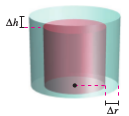Calculus III Advanced (Course) (13.4) (Homework)
Contents
Section 13.4 Homework
From Calculus 10e by Larson and Edwards, p. 905. Exercises 14, 26, 30.
Exercise 13.4.14 Using a Differential as an Approximation
(a) Evaluate \(f(2,1)\) and \(f(2.1,1.05)\) and calculate \(\Delta z\).
(b) Use the total differential \(dz\) to approximate \(\Delta z\).
- $$ f(x,y) = \frac{y}{x}$$
Solution (a) Rewrite as
- $$ z = \frac{y}{x}$$
Solve for \(f(2,1)\) and \(f(2.1,1.05)\)
- $$ f(2,1) =\frac{1}{2} = 0.5 $$
- $$ f(2,1) =\frac{1.05}{2} = 0.5 $$
- $$ f_{x}(x,y) = \left(- \frac{1}{x^{2}} \right)y $$
- $$ f_{y}(x,y) = \frac{1}{x} $$
- $$ \Delta z = f(2.1,1.05) - f(2,1) = 0 $$
(b)
- $$ df = \left(- \frac{1}{x^{2}} \right)y\:dx + \frac{1}{x}\:dy $$
- $$ df = - \frac{1}{2^{2}} 0.1 + \frac{1}{2} (0.05) = 0 $$
Exercise 13.4.26 Volume
The volume for the red right circular cylinder in Figure 1 is \(V=\pi r^{2}h\). The possible errors in the radius and height are \(\Delta r\) and \(\Delta h\). Find \(dV\) and identify the solids in the figure whose volumes are given by the terms for \(dV\). What solid represents the difference between \(\Delta V\) and \(dV\)?
Solution
- \( V(r,h) = \pi r^{2}h \)
- \(dV = 2\pi r h \:dr + \pi r^{2} \:dh
Exercise 13.4.30 Volume
The possible error involved in measuring each dimension for a right circular cylinder is \(\pm 0.05\) centimeter. The radius is 3 centimeters and the height is 10 centimeters. Approximate the propagated error and the relative error in the
calculated volume for the cylinder.
Solution
- \(V(r,h) = \pi r^{2}h\)
- \(V(3,10) = \pi 3^{2} \cdot 10 = 90 \pi \approx 282.74 \text{cm}^{3}\)
- \(dV = 2 \pi r h \:dr + \pi r^{2} \: dh\)
- \( |dV| = 2\pi 3 \cdot 10 \cdot 0.05 + \pi 3^{2} \cdot 0.05 \approx 10.84\)
The possible error is about \(10.84\: \text{cm}^{3}\).
The relative error is about
- $$ \frac{dV}{V} = \frac{10.84}{282.74} \approx 0.038$$
Internal Links
Parent Article: Calculus III Advanced (Course)
